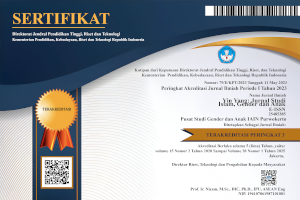PENDIDIKAN GENDER HARMONI DALAM KONSTRUKSI RUMAH ADAT KUDUS
Abstract
Abstrak: Tulisan ini membahas tiga hal: (1) Bagaimana memahami hunian dalam rumah adat Kudus sebagai proses pendidikan harmoni gender? (2) Apa konteks sosial dari rumah adat Kudus? (3) Apa nilai-nilai pendidikan harmoni gender dalam pembangunan rumah adat Kudus? Makalah ini menggunakan pendekatan sosiologis terutama sosiologi post-strukturalisme yang dikombinasikan dengan interpretasi budaya. Kesimpulan dari makalah ini adalah: (1) Rumah adalah lingkungan terdekat manusia di mana di dalamnya ide-ide utama budaya diproduksi dan direproduksi untuk membentuk sistem makna. Kehadiran rumah adat yang sarat dengan ornamen-ornamen mencerminkan nilai-nilai moral yang dipegangi dan harus diwujudkan dan diimplementasikan. Nilai-nilai moral tersebut dipegangi dalam rangka membangun keharmonisan gender, hal ini penting karena dalam system hubungan antara penghuni rumah tidak dapat dipisahkan adanya hubungan antara laki-laki dan perempuan, (2) Nilai-nilai pendidikan karakter harmoni gender dalam keluarga yang tercermin pada simbol/makna dalam rumah adat (tradisional) dapat digunakan sebagai referensi (alternatif) praktek terbaik dalam harmoni gender dan sekaligus bisa menjadi acuan untuk pendidikan keluarga, karena di situ ada semangat kesetaraan gender, baik dalam hubungannya dengan Tuhan, dengan manusia, dan juga dengan lingkungannya. This paper discusses three things: (1) How to understand that the occupancy in the traditional house of Kudus as an educational process of gender harmony? (2) What are the social context of the traditional house of Kudus? (3) What are the values of gender harmony education in the construction of the traditional house of Kudus? This paper uses sociological approach especially on post-structuralism sociology in combined with cultural interpretation. The conclusions of this paper are: (1) The house is the most familiar human environment within the domestic sphere as in the home are the main ideas of culture are produced and reproduced to form a system of meaning. The presence of the traditional house is loaded with ornaments wrapped with the meaning of the existence of the system reflects the moral values ​​which way of life in occupied must be actualized and implemented. Then occupied in this case is as apprenticeships in building cultural harmony gender could not be separated because of the presence of occupants in the system of relations between men and women; (2) The Values ​​of character education in term of gender harmony in the family is reflected in the networks of meaning in the traditional house can be used as an alternative reference of best practices in a habitable and could well be a reference to float the family education because it also shows the spirit of gender equality both in relation to God, to human beings, to him/herself and also to interact with its environment. Despite these efforts would require appropriate adaptation and adjustment needs of the times and the context in which it was done family education. Kata Kunci: Pendidikan Harmoni Gender, Rumah Adat Kudus, Nilai-nilai Moral.Downloads
Download data is not yet available.
Downloads
Published
2018-01-18
How to Cite
Said, N. (2018). PENDIDIKAN GENDER HARMONI DALAM KONSTRUKSI RUMAH ADAT KUDUS. Yinyang: Jurnal Studi Islam Gender Dan Anak, 8(2), 102–121. Retrieved from https://ejournal.uinsaizu.ac.id/index.php/yinyang/article/view/1156
Issue
Section
Articles
License
Authors who publish with this journal agree to the following terms: Authors retain copyright and grant the journal right of first publication with the work simultaneously licensed under a Creative Commons Attribution-ShareAlike 4.0 International License that allows others to share the work with an acknowledgment of the work's authorship and initial publication in this journal.

















